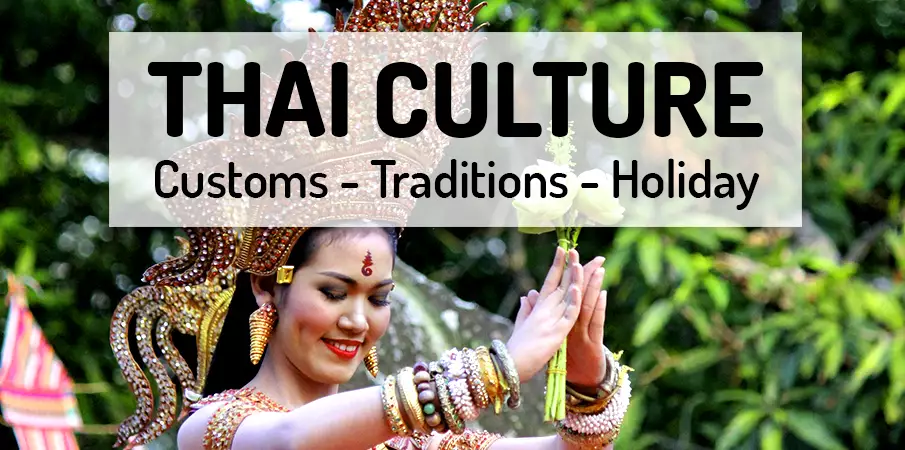
1. Religious Tolerance
2. Family Values
3. King / Monarchy
4. Dining Customs
5. Village Markets
6. Martial Art
7. Museum / Gallery
8. Loi Krathong
9. Art + Dance
10. Wai Greeting
Thai Culture – Customs, Traditions and Colorful Festivals.
Entering the heart of Thailand means entering a captivating world where ancient traditions blend with the modern pulse of life. As you stroll through Thai streets, inhale the aroma of exotic spices and foods, and the sounds of traditional music fill the air, you’ll realize that you are in a place where culture and customs not only live but literally dance at every step. Thai culture, rich and diverse, is like a fascinating mosaic, composed of ancient traditions, religious rituals, and modern ways of life.
The Enchantment of Buddha’s Tranquility:
-
- Thailand, the Land of Smiles, not only reveals its beauty in stunning beaches or lush jungles but deeply embeds it in the daily life of its people. When you step into the world of Thai culture, you become part of a story that has been written since time immemorial and yet is constantly evolving.
- What most influences Thai daily life is Buddhism. Its tranquil message of peace and harmony permeates every alley and every home. Whether you observe morning rituals in temples, where the scent of incense blends with the gentle rustle of leaves, or watch people in prayers, you’ll find that religion is the heart of daily existence. However, in this religious kaleidoscope, it doesn’t confine itself to temples; it reflects in customs, traditions, and everyday decisions.
Family Shrine of Traditions:
-
- Family in Thailand is not just a community of people sharing the same house but a shrine of values, traditions, and mutual support. Hierarchy is present, but not as a burden; it’s a bond that connects generations and teaches respect and care for elders. The family is like roots from which the strong tree of Thai culture grows.
- And what to say about the king and monarchy, symbols of stability and unity? The Royal Palace in Bangkok not only charms you with its architecture but also with an atmosphere of reverence and gratitude. For Thais, the king is not only a sovereign but also the father of the nation, and respect for him is evident in everything, from small pictures on walls to portraits in everyday life.
- And so, when you step into the Thai world, you are not just spectators; you become part of a living theater where colors, scents, and sounds dance together in the air. Prepare for a journey into the heart of Thai culture, where every moment is like a page turned in a book that is still being written and is still fascinating.
BOOK a TOUR / ACTIVITY in Thailand ➜
10 Important Aspects of Thai Culture and Traditions:
1. Buddhism and Religious Tolerance:
-
- Thai culture, firmly rooted in Theravada Buddhism, carries the philosophy of peace and harmony on its shoulders, forming the foundation for a unique atmosphere of religious tolerance in the Land of Smiles. The teachings of Buddha, emphasizing kindness, compassion, and impartiality, permeate the daily lives of the Thai people who find meaning and inspiration in this religion.
- Traditional Thai temples, such as the majestic Wat Pho or the charming Wat Arun, are not just places of worship but also serve as meeting grounds for sharing wisdom. In these sacred spaces, not only religious ceremonies take place, but people also gather for meditation and learning. Buddhism in Thailand is not an isolated faith but a comprehensive way of life linked with everyday expressions of tolerance.
- In an interesting contrast to the predominant Buddhism, Thailand is home to minorities of followers of other religions, such as Muslims and Christians. This religious diversity is not a source of conflict but, on the contrary, contributes to the richness of Thai culture. Due to openness and respect for different religions, these communities are fully integrated into society, sharing traditions and mutually influencing each other.
- Religious tolerance in Thailand is more than just a verbal statement; it is a deeply rooted attitude in the heart of daily life. In families, you can find members practicing different religions, yet they participate together in traditional ceremonies and festivals, illustrating mutual respect and unity. The Land of Smiles thus becomes a model of religious tolerance, creating a unique and harmonious image of Thai culture within the global community.
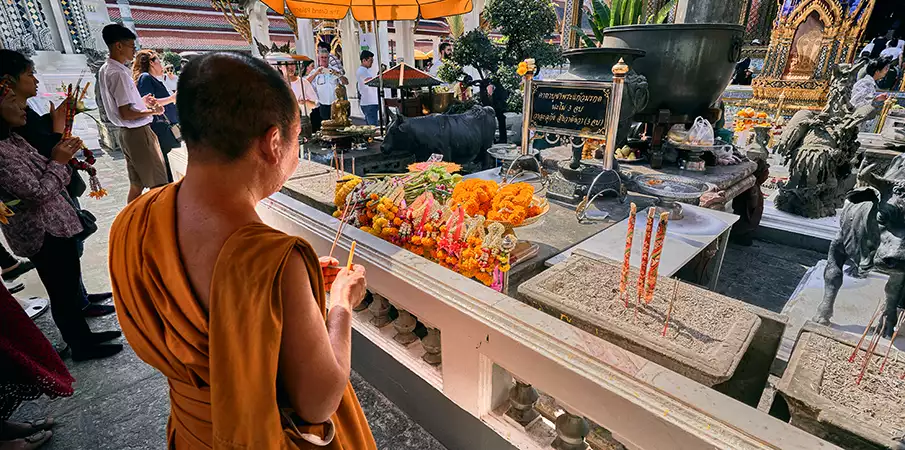
2. Family Values in Thailand:
-
- Thai culture stands out not only for its exotic cuisine and captivating art but also for its strong foundation in family values. Family in Thailand is more than just a group of people sharing the same roof; it is a sanctuary of traditions, mutual support, and indelible family bonds. In Thai society, the family plays a crucial role in shaping individuals‘ identities. Family hierarchy is respected, creating a solid framework for mutual care. Older generations are particularly revered, and their wisdom is considered a valuable gift to younger family members.
- Mutual support within the family manifests in daily life. Thai people often share communal moments during meals, which go beyond mere sustenance. Shared meals are moments of bonding, laughter, and strengthening family ties. Family bonds are also evident during traditional Thai festivals and celebrations. People gather to celebrate not only important family events but also community events. Mutual help and support become essential parts of these occasions, creating a stronger sense of community.
- Special attention is given to child upbringing. Young individuals are taught traditions and family values from the eldest family members. Respect for authority and elders is considered a key element in upbringing, reinforcing bonds between generations. The legacy of ancestors and traditions is passed down with love and pride, forming the foundation for Thailand’s unique and harmonious culture.
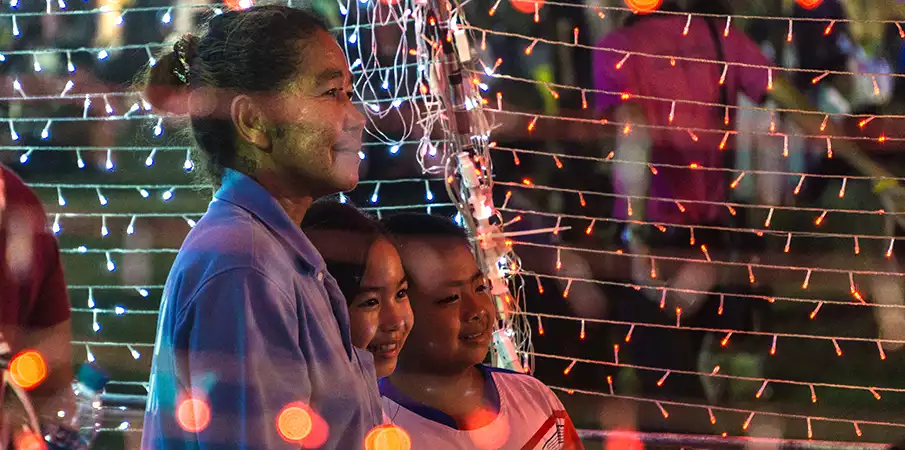
3. King and Monarchy in Thailand:
-
- Thai monarchy, deeply rooted in the country’s history, plays a crucial role in shaping Thai identity and societal stability. The king, as a symbol of unity and protector of traditional values, holds an exceptional place in the hearts of the people. The Thai monarchy, reaching back to antiquity, is known for its stability and continuity. The king is not just the head of the state; the figure is intertwined with spiritual values and love for the nation. Historical stories of kings, from ancient Ayutthaya monarchs to the current king, are part of the national identity.
- Respect for the monarchy is not only a duty for Thais but also arises from a deep sense of pride in their country. Images of the king adorn homes and public places, reminding citizens of their dedication and loyalty. The royal family is considered the center of Thailand’s political and cultural stability.
- The king is also linked to religion and tradition. His participation in religious ceremonies and rituals strengthens the monarchy’s connection with Buddhism, providing a sense of spiritual unity for the people. The king is also a patron of the arts, education, and charitable activities, promoting the development of culture and community.
- In recent decades, the monarchy in Thailand has adapted to modern times, preserving its key role at the heart of society. The king and his family remain symbols of stability and unity, providing Thais with a sense of security and pride in their history. The monarchy in Thailand is not just an institution; it is a living element that reinforces national unity and the cultural heritage of the country.
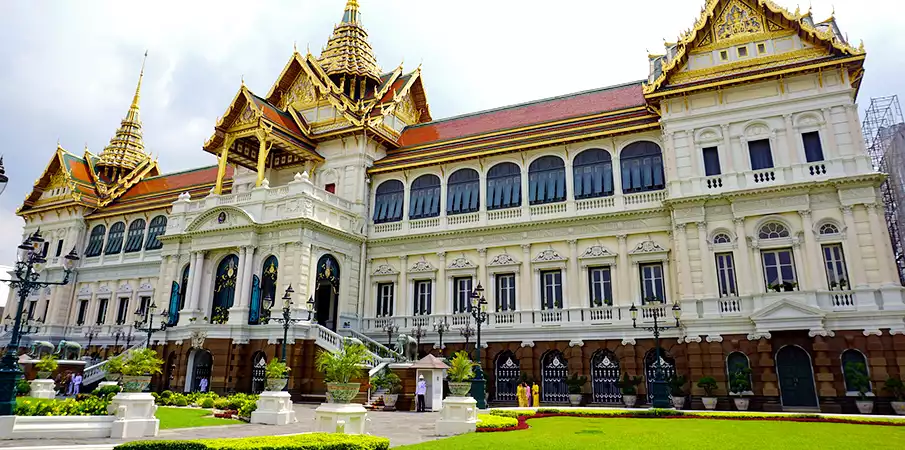
4. Food and Dining Customs in Thailand:
-
- Thai culture extends beyond monuments and traditions to a vibrant and diverse palette of flavors reflected in Thai cuisine. Dining in Thailand is not just a necessity but a genuine social ritual associated with joy, sharing, and pleasant moments. Thai cuisine is renowned for its spiciness, sweetness, sourness, and harmonious combination of different tastes. Food here is not just a means to satisfy hunger but also a way to celebrate society and share joy with family and friends.
- Traditional Thai meals are often served on communal tables, where guests can freely participate in choosing and combining dishes. Larger groups of people enjoy ordering various dishes and then sharing tastes with each other. This style of dining encourages social interaction and creates a warm and friendly atmosphere.
- One peculiarity of Thai dining is the use of a fork and spoon instead of a knife and fork. During meals, dishes are cut into smaller pieces and consumed together with rice. This dining style not only facilitates the consumption of rice, which is a staple of Thai cuisine but also emphasizes the sharing of the dining table.
- In Thailand, it is also common for people to greet each other with the question „Have you eaten?“ instead of the traditional „Hello!“ or „How are you?“. This reflects the importance of food and communal dining in society. Food here is not just a necessity but a ritual that brings people together and strengthens social bonds.
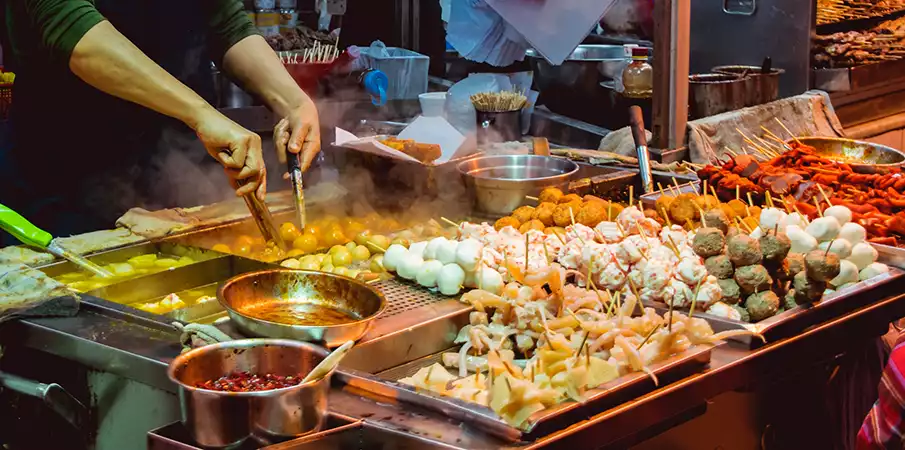
5. Tradition of Village and Urban Markets:
-
- Village and urban markets in Thailand are not just places of trade but the true heart of communities where traditional crafts, exotic scents, and friendly smiles converge. These markets, full of colors and life, are a vibrant expression of Thai culture that venerates authenticity and social cohesion.
- Regular village markets, known as „talad,“ mirror everyday life in Thai communities. Each market has its unique character and offers a diverse range of fresh produce, handicrafts, and traditional Thai delicacies that appeal to all the senses.
- Strolling through the aisles of a village market is a true adventure for your taste buds. Exotic fruits, fresh fish, aromatic spices, and traditional dishes straight from the woks entice you to taste. The market is not just a place for shopping but also for exploring and discovering new flavors and scents.
- Village markets are where old and new generations meet. Long-time residents come for their favorite treats, and independent craftsmen offer traditional products such as hand-embroidered fabrics or unique ceramics. All of this creates an unforgettable atmosphere that turns village markets into places for sharing stories and traditions.
- Markets are not just about food and goods but also about social gatherings. Locals gather, exchange news, and share joys and concerns. For foreigners, it is a unique opportunity to step into the heart of Thai society and experience authentic everyday life. Village markets in Thailand are not merely spaces for trading but also a living expression of a rich culture where tradition, taste sensations, and social encounters intertwine in a colorful dance.
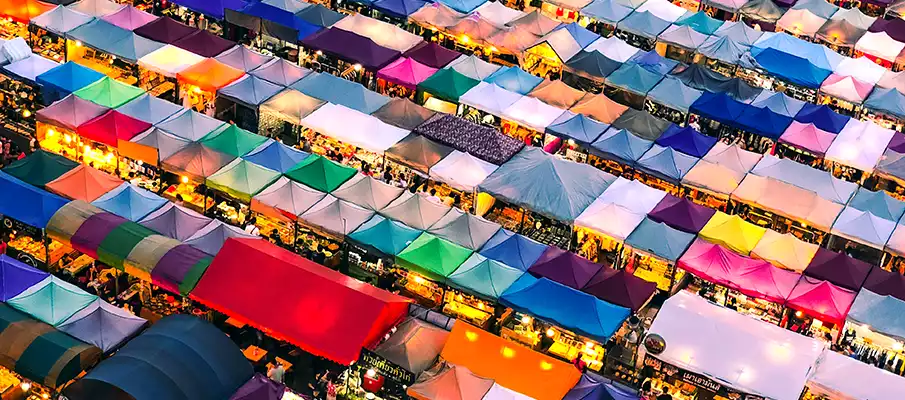
6. Muay Thai – Thai Boxing:
-
- Muay Thai, also known as Thai Boxing, is not just a sport; it is a reflection of history, culture, and the spirit of determination in Thailand. This martial art is not only about physical strength but also an elegant fusion of physical discipline, mental preparation, and respect for tradition.
- Muay Thai is a highly aesthetic art where fighters combine technique, grace, and power. The main tools are not only hands and feet but also elbows and knees, giving Muay Thai the reputation of the „art of eight limbs.“ Each movement has its meaning, and each fighter strives for perfection in technique.
- In Muay Thai, not only physical strength but also mental resilience is considered a key element of success. Fighters are trained in discipline, patience, and respect for opponents. Each match is not just a sporting event but also a ritual where traditions and the spirit of combat are revered.
- The tradition of Muay Thai dates back deep into Thailand’s history when it was used in military conflicts. Today, Muay Thai has become a national symbol and a beloved sport throughout Thailand. Muay Thai matches are an exciting spectacle where skills, passion, and heroism converge.
- Thai boxing is not just about competing in the ring; it is also about preserving heritage. Many fighters go through traditional rituals before a match to honor their teachers, protect themselves from harm, and bring good luck. These rituals showcase that Muay Thai is based not only on physical strength but also on respect for tradition and the strength of the spirit.
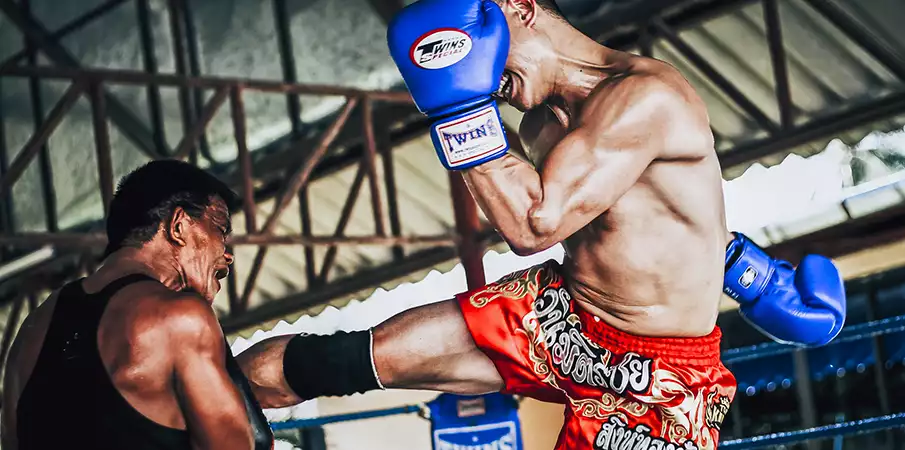
7. Beauties of Thai Art: Traditional Museums and Galleries
-
- Thai culture is immersed in the richness of artistic heritage, which can be explored in traditional museums and galleries. The Thai art scene offers a diverse mix of traditional and modern elements, providing visitors with a unique perspective on the country’s rich cultural palette.
- Traditional Thai museums, such as the Bangkok Art Museum or the National History Museum in Chiang Mai, showcase arts and crafts from various periods of Thai history. Visitors can admire treasures of Thai sculpture, paintings, and craftsmanship, offering a profound insight into the country’s artistic heritage.
- With the growing influence of modern artists, modern art galleries are becoming increasingly popular. Cities like Chiang Mai or Phuket are known for their vibrant art scenes. Galleries here often host exhibitions by bold and innovative artists who blend traditional Thai elements with modern artistic expression.
- Visiting these institutions is not just about admiring the beauty of Thai art but also about deepening understanding of Thailand’s cultural roots and development. Museums and galleries in Thailand serve as a bridge between the past and the present, providing visitors with a unique view of cultural differences and the richness of this beautiful country.
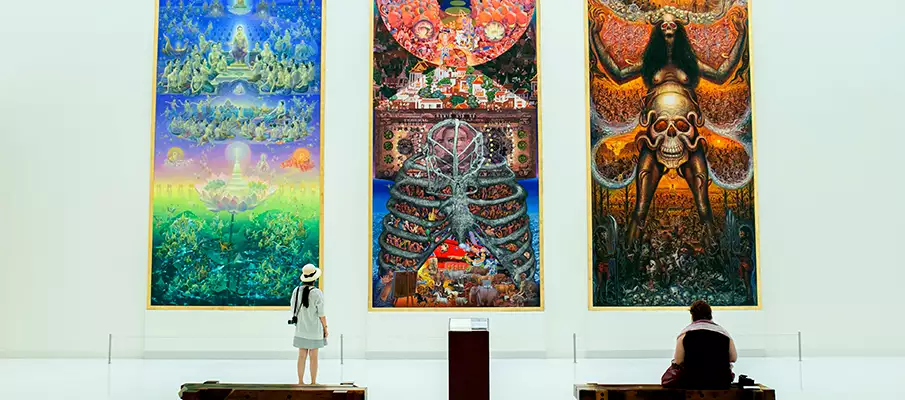
8. Loi Krathong – Festival of „Floating Baskets“
-
- Annually in November, Thailand hosts the unique festival known as Loi Krathong, celebrating light, water, and spirituality. This enchanting festival, adorned with flowers and illuminated by thousands of candles, creates a magical atmosphere intertwined with Thai culture and traditions.
- Central to Loi Krathong are krathongs, small floating baskets made of banana leaves, flowers, candles, and incense sticks. People release these krathongs onto rivers, lakes, and ponds with wishes and prayers. This symbolic act represents purification from the past, gratitude for the abundance of water, and connection with one’s own soul.
- On the day of Loi Krathong, the water surface gleams with thousands of candles, creating a magical image of a light strip dancing on the waves. People pray together and express thanks for the water, a vital source of life for the Thai people. Lighting candles on the water also symbolizes gratitude for forgiveness of sins and the pursuit of happiness and love in the future.
- Loi Krathong is not just a public celebration; many families create their own krathongs and collectively craft floating works of art. In some areas, traditional dance performances, music, and festival games are also organized. Loi Krathong is not only a visual festival full of light and water but also a spiritual event connected to tradition and harmony.
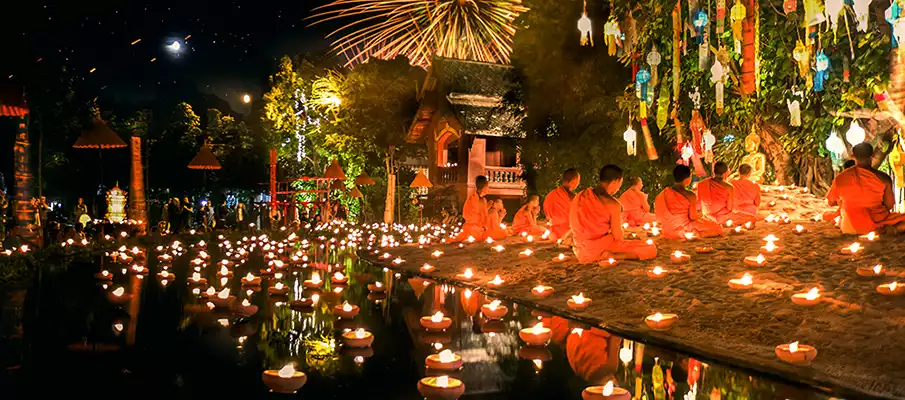
9. Traditional Art and Dance in Thailand:
-
- Thai traditional art and dance are integral components of the rich cultural tapestry of this country. This artistic form embodies not only aesthetics and grace but also profound meaning connected to history, religion, and everyday life.
- Traditional Thai dance, known as „Khon,“ has its roots in the Thai royal court. This royal dance combines movements, costumes, and music, often narrating historical or religious stories. Khon dance is not just a display of graceful motions but also a form of expression conveying essential values and stories of Thai culture.
- Another expression of Thai art is traditional Thai painting, which combines beauty with spiritual significance. Some of the most renowned Thai paintings are associated with Buddhist motifs and stories, depicting the life of Buddha and Buddhist mythology.
- In traditional villages, one can also witness craftsmanship skills, such as wood carving, fabric weaving, or the production of traditional ceramic goods. These crafts are passed down from generation to generation, representing a crucial part of cultural identity.
- Thai art and dance are not static; they evolve and adapt over time. Modern artists combine traditional elements with new techniques, creating artworks that reflect the dynamics of contemporary Thai society.

10. Wai – Traditional Greeting:
-
- In Thai culture, every greeting seems to be an expression of respect and reverence, and the „Wai“ tradition is one of the most characteristic ways to convey greetings and acknowledgment in Thailand. Wai is not just a gesture of politeness; it is also a unique expression of Thai culture and values.
- Wai is a gesture involving pressing the palms together in front of the face with a slight bow of the head. This greeting is not merely a routine act; it also conveys hierarchy, relationships, and the level of respect. Depending on how high the hands are placed and how much the head is bowed, it can express different levels of respect.
- Wai is not only a form of greeting but also an expression of gratitude and acknowledgment. It is common for a younger person to perform the Wai towards an elder or authority figure, and the recipient responds in kind. Family relationships, work hierarchies, and public encounters are just a few situations where Wai is a common and expected expression of politeness.
- This gesture also reflects the importance of hierarchy and respect in society. Beyond mere words, Wai can build and strengthen relationships between people, creating a pleasant atmosphere in society. Even foreigners are typically welcomed with the Wai, showcasing the openness and hospitality of the Thai people.
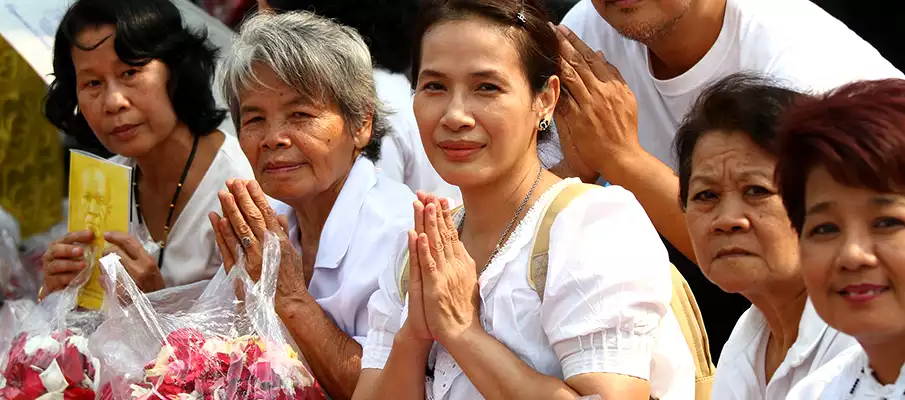
10 Important and Revered Festivals in Thailand:
Thai festivals are a vibrant reflection of the country’s rich cultural traditions and religious heritage. Each festival has its own significance and symbolism, linked to historical events, religious traditions, or natural cycles. These festivals are also a significant opportunity for social gatherings, expressions of gratitude, and paying homage to ancestors. The following list provides an overview of the ten most important and revered festivals in Thailand, each accompanied by a brief description of its significance and the customs associated with its celebration.
-
- 1. Songkran (New Year): Songkran is the Thai New Year and one of the most anticipated festivals. The celebrations last for several days and are known for the traditional ritual of people splashing water on each other, symbolizing purification and renewal. This celebration is also associated with temple visits and showing respect to older family members.
- 2. Loi Krathong (Festival of Lights): Loi Krathong celebrates the beauty of Thai waters and rivers. People release small floating vessels called krathong with lit candles onto the water, symbolizing the release of negative emotions and wishes for a new period of positivity.
- 3. Vesakha Bucha (Birth, Enlightenment, and Passing of Buddha): This Buddhist festival commemorates three key events in Buddha’s life: birth, enlightenment, and passing. On this day, believers visit temples, pay homage to Buddha, and practice acts of charity.
- 4. Asahna Bucha (Events Associated with the Beginning of Buddhism): Asahna Bucha recalls the first sermon of Buddha on the Four Noble Truths and his first five disciples. On this day, processions take place, and temples host solemn ceremonies and meditations.
- 5. Coronation Day: Coronation Day is dedicated to commemorating the coronation of the Thai monarch. People organize festive events, pay homage to the king, and express their allegiance to the monarchy.
- 6. King Bhumibol Memorial Day: This day is dedicated to remembering King Bhumibol Adulyadej, who was a long-reigning Thai monarch. People participate in ceremonies to express their respect and gratitude for his service and contributions to the country.
- 7. Chulalongkorn Day: Celebrating the birthday of King Chulalongkorn, known for his modernization reforms. People reflect on this day on his contributions to the country’s development.
- 8. Constitution Day: Constitution Day celebrates the adoption of the first constitution in 1932 and the establishment of a constitutional monarchy in Thailand. Celebrations include parades and festivities honoring the constitution and democratic values.
- 9. Magha Puja (Day of Great Assembly): Magha Puja celebrates the moment when 1,250 arahants, the most significant disciples of Buddha, came to him without prior agreement. Believers gather at temples, practice meditation, and perform good deeds.
- 10. National Father’s Day: National Father’s Day commemorates the birthday of Thai King Rama IX, considered the father of the nation. People express gratitude and respect to fathers and show love for the monarchy.
Thai festivals are a radiant expression of cultural diversity and the country’s religious heritage. The celebrations blend traditional rituals with modern trends, bringing a sense of community and gratitude into the lives of the Thai people. Each of these festivals plays a crucial role in strengthening Thailand’s identity and fostering relationships among its inhabitants.

❓ FAQ – Thai Culture, Traditions and Customs:
1. What is the significant role of Buddhism in Thai culture?
-
- Buddhism in Thailand is not just a religion but deeply ingrained in everyday life. Many Thais practice Buddhism, and daily rituals such as almsgiving, prayers, and temple visits are common. Monks are respected and play a key role in the community.
2. How does traditional Thai architecture manifest in temples and buildings?
-
- Traditional Thai architecture stands out with intricate designs of temples and buildings. Temple tiers, golden reliefs, and vibrant colors are common. Buildings blend traditional Thai elements with Buddhist symbols, creating an impression of elegance and spirituality.
3. What are the main traditional Thai festivals?
-
- Songkran, the Thai New Year, is a time for cleansing and renewal. Celebrations include massive water battles symbolizing the cleansing of the past. Loy Krathong, the Festival of Lights, involves floating decorated vessels with candles and flowers on water.
4. What is the significance of traditional Thai dances?
-
- Traditional Thai dances are a vital part of cultural heritage. For example, the Khon dance drama presents epic stories and legends through movements, music, and elaborate costumes. These dances not only entertain but also convey historical and religious narratives.
5. How does Thai cuisine manifest, and what are typical dishes?
-
- Thai cuisine is known for the harmony of flavors – sweet, salty, sour, and spicy. Popular dishes include Pad Thai, green curry, Tom Yum, and many more. Street food markets offer authentic taste experiences.
6. How does art and crafts manifest in traditional Thai culture?
-
- Traditional arts and crafts in Thailand include sculpture, silk painting, traditional embroidered fabrics, and ceramics. These unique craft techniques reflect the country’s history and rich traditions. Many of these products can be purchased at various markets in cities or villages.
7. What are typical traditional costumes in Thailand?
-
- Traditional Thai attire includes Sukhothai, a traditional Thai costume. Women wear sarongs or „chut thai,“ traditional dresses. Men wear „pha nung“ (traditional pants) and „pa sin“ (traditional tunics) during formal events and festivals.
8. What are traditional forms of arts and entertainment in Thai culture?
-
- Thai arts include traditional music, dance, and artistic performances. Muay Thai (Thai boxing) is a popular sport that combines traditional techniques with martial arts. Musical instruments like khim and ranat add unique sounds to Thai art.
9. How do family values manifest in Thai society?
-
- Family plays a crucial role in Thai society and is based on respect for elders. Traditional values emphasize family gatherings, support during significant life events, and mutual care.
10. What are traditional Thai methods of healing and health care?
-
- Traditional Thai massage, combining acupressure and yoga elements, is a popular method for relaxation and muscle relief. Thai herbal medicine and yoga are also traditional ways of caring for health and maintaining the balance of body and mind.
11. What is the significance of the Thai king?
-
- The Thai king holds a special position in Thai society and is considered a symbol of unity and stability. Respect for the monarchy is deeply rooted in cultural and historical traditions. The king is seen as the father of the nation, and his image is ubiquitous in social life. People express their allegiance to the king through various rituals and displays of respect, including a commitment to preserving his dignity and prestige.
12. What are traditional customs in Thai society related to life events?
-
- Traditional Thai customs and rituals are closely tied to significant life events. For example, births, weddings, and funerals have specific traditions and ceremonies. Rituals during the birth of a new family member ensure happiness and prosperity. Wedding ceremonies include rituals associated with respect for parents and the exchange of vows. Funeral rituals reflect a belief in reincarnation and prepare the deceased for the journey to the next life. Each of these rituals represents an important element of Thai culture and preserves traditions passed down from generation to generation.
13. How to handle money in Thailand, what to use for payment?
-
- In Thailand, you have several options for managing money. Cash in Thai baht is widely accepted in most places, especially in smaller shops, markets, and local establishments. However, card payments are common in hotels, restaurants, and large stores, and most international credit cards, such as Visa and MasterCard, are widely accepted. It’s always good to have cash in Thai baht. More here: Money and Currency in Thailand.
BOOK a TOUR / ACTIVITY in Thailand ➜
| Facts and Insights about Thai Culture: | Detailed Description |
|---|---|
| 1. Royal Reverence: | Thai culture deeply honors the monarchy, especially the king. The king and queen hold a unique place in the hearts of Thais, and their respect and devotion are evident in people’s daily behavior. Royal matters and celebrations are highly significant for Thai society and manifest in various forms of public displays of respect. |
| 2. Traditional Dances and Arts: | Thai traditional dance, including the dance drama Khon, and artistic forms like sculpture and painting, carry profound historical and religious stories. These artistic forms not only express creativity but also serve as a means of transmitting traditional values and stories across generations. Each movement in dance and every brushstroke in painting has its own meaning, allowing artists to communicate with viewers beyond words. |
| 3. Buddhism and Monasteries: | Buddhism plays a crucial role in Thai culture. Monasteries are not only places of worship but also community and education centers. People visit monasteries not only for prayers but also for learning and community support. Each monastery is unique in its way and represents an essential part of Thai heritage. |
| 4. Loy Krathong Festival: | Loy Krathong is a magical Thai festival celebrating the beauty of water and bringing the community together. People release small floating vessels (krathongs) onto water surfaces, while lanterns float in the air. This festival expresses gratitude for water, a key element in the Thai way of life, and celebrates the romance and beauty of Thai culture. |
| 5. Muay Thai – National Sport: | Muay Thai, also known as Thai boxing, is not just a sport in Thailand; it is part of cultural identity. The history of Muay Thai dates back to fighters battling for their freedom. Today, Muay Thai is not only a sport but also an art that combines strength, skill, and discipline. Muay Thai matches are not just a sporting experience but also a cultural phenomenon that attracts attention worldwide. |
| 6. Thai Cuisine: | Thai cuisine is one of the tastiest and most diverse in the world. The combination of sweet, sour, spicy, and salty flavors creates a unique experience for taste buds. Each region has its specialties, using fresh herbs and spices, giving Thai dishes an unmistakable taste. Rice, a staple of Thai food, is served with every meal. |
| 7. Rice Paddy Rowing Tradition: | The tradition of rowing in rice paddies, known as „Loy Krathong,“ celebrates the rice harvest, a fundamental food source for Thai society. Rowing races on water surfaces surrounding rice fields are not only a fun activity but also a reminder of the importance of rice in Thai diet and culture. |
| 8. Traditional Thai Attire – Chut Thai: | Traditional Thai attire, known as Chut Thai, showcases a vibrant palette of beautiful patterns and colors. For women, a typical piece of clothing is „Sinh,“ which are long skirts, often adorned with patterns using special techniques like batik. Men can wear „Pha Nung“ – traditional pants complemented with a stylized shawl over the shoulders. This traditional attire is still worn on special occasions and festive events, representing a significant element of Thai culture. |
| 9. Respect for Elders: | In Thai culture, respect for elders is crucial. The younger generation shows respect and care for their elders both in family and public spaces. Traditional customs like bowing to elders and paying respect are common practices in Thai daily life, reflecting a deep reverence for seniors. |
| 10. Artistic Crafts and Markets: | Thai culture is rich in artistic crafts, from traditional sculpture to weaving and ceramics. Markets, such as the famous Chatuchak in Bangkok, are vibrant hubs for discovering these unique artworks and crafts. Markets reflect the diversity of Thai artistic heritage and offer visitors the opportunity to purchase authentic and handmade pieces that tell stories of traditional Thai culture. |
Food in Singapore|Food / Cuisine in Laos|Food / Cuisine in Cambodia|Food / Cuisine in Malaysia|Money / Currency in Laos|Money in Cambodia





